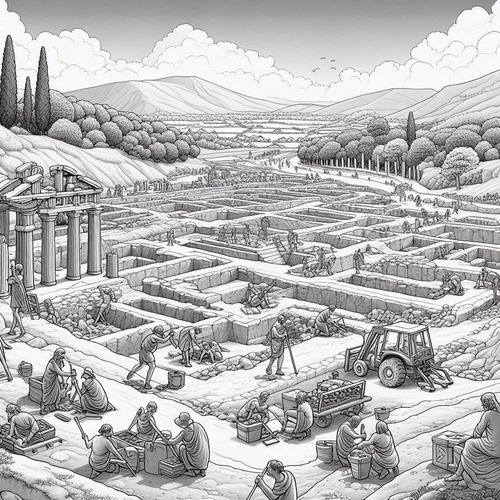Historical Reliability of the Bible: Astonishing Archaeological Finds
Archaeological and Manuscript Evidence
For centuries, the Bible’s historical reliability has been scrutinised, challenged, and debated. Over the years, however, a wealth of evidence has emerged from meticulous research and groundbreaking discoveries, solidifying the Bible’s authenticity and accuracy. This comprehensive exploration delves into the archaeological finds, manuscript preservation, and narrative coherence that affirm the Bible’s unwavering historical reliability.
Archaeological Treasures—Unearthing Biblical Truths:
Archaeology has played a pivotal role in corroborating the Bible’s accounts, providing tangible evidence that brings its narratives to life. Excavations across the Middle East have unveiled ancient cities and civilizations, validating the existence of places and peoples recorded in the Scriptures.
- Ancient Cities and Civilizations Discovered
- Jericho: Excavations at the site of ancient Jericho have uncovered evidence of a city that was destroyed around 1400 BCE, aligning with the biblical account of its conquest by the Israelites under Joshua’s leadership (Joshua 6). The fallen walls and the remains of burned structures bear witness to the event described in the Bible.
- Nineveh: The discovery of the ancient city of Nineveh, the capital of the Assyrian Empire, has corroborated the accounts of the prophets Jonah and Nahum. Excavations have unearthed palaces, inscriptions, and reliefs that match the descriptions found in the Bible, shedding light on this once-mighty civilization.
- Hittites: Once dismissed as a biblical myth, the Hittite civilization has been confirmed through archaeological discoveries in Turkey. Inscriptions and artefacts have validated references to this ancient empire in the Old Testament books, including Genesis, further solidifying the Bible’s historical accuracy.
- Key Biblical Figures Brought to Life
Archaeological finds have also uncovered evidence of prominent figures mentioned in the Bible, lending credibility to their historical existence and the events surrounding their lives.
- King David: The Tel Dan Stele, a remarkable inscription discovered in northern Israel, contains a reference to the “House of David,” providing the first extra-biblical evidence of King David’s dynasty, as recorded in the biblical narrative.
- Pontius Pilate: The Pilate Stone, found in Caesarea Maritima, bears an inscription mentioning Pontius Pilate, the Roman governor who presided over the trial of Jesus Christ. This discovery confirms Pilate’s historical existence, lending credence to the New Testament accounts of Jesus’ crucifixion.
- Caiaphas: The ossuary (bone box) of Joseph Caiaphas, the high priest involved in the trial of Jesus, was discovered in Jerusalem. This archaeological find lends credibility to the New Testament accounts of Caiaphas’s role in the events surrounding Jesus’ death and resurrection.
Manuscript Integrity—Preserving the Word
Beyond archaeological evidence, the Bible’s reliability is further reinforced by the remarkable preservation and consistency of its manuscripts over millennia. The abundance of manuscripts, their early dating, and the meticulous transmission process have ensured the integrity of the biblical text.
- Abundance of Manuscripts: A Wealth of Corroboration
- Old Testament: The discovery of the Dead Sea Scrolls in the mid-20th century revealed texts from almost every book of the Old Testament, dating back to the 3rd century BCE. These scrolls are remarkably consistent with the Masoretic Text, the authoritative Hebrew text of the Jewish Bible, further validating the accurate transmission of the Old Testament.
- New Testament: Over 5,800 Greek manuscripts of the New Testament exist, some dating as early as the 2nd century CE. This abundance of manuscripts allows for cross-referencing and verification, ensuring the accuracy of the text’s preservation.
- Early Dating of Manuscripts: Minimizing Corruption
- Old Testament: The Septuagint, a Greek translation of the Hebrew Bible dating back to the 3rd century BCE, provides an early witness to the consistency of the Hebrew texts, reducing the likelihood of significant textual corruption over time.
- New Testament: The John Rylands Papyrus (P52), dated to around 125 CE, contains fragments of the Gospel of John. Its early dating provides a close link to the original autographs, further attesting to the faithful preservation of the New Testament text.
- Meticulous Transmission: Minimizing Error
The meticulous copying process employed by Jewish scribes, known as the Masoretes, played a crucial role in preserving the Old Testament text with remarkable fidelity. These scribes counted every letter, word, and verse to ensure accuracy, adhering to rigorous standards of transmission that have safeguarded the Scriptures for generations.
Consistency and Coherence: A Unified Narrative
Despite having been written over a span of more than a millennium by around 40 different authors from various backgrounds, the Bible maintains remarkable consistency and coherence in its narrative. This unified message across diverse genres and historical contexts is a testament to its reliability and divine inspiration.
- Prophecy and Fulfilment: Foretelling the Future
- Messianic Prophecies: The Old Testament contains numerous prophecies about the coming Messiah, all of which were fulfilled in the person of Jesus Christ. The remarkable detail and accuracy of these prophecies, such as Isaiah 53’s description of the suffering servant, align with the accounts of Jesus’ crucifixion and resurrection, validating the Bible’s prophetic reliability.
- Historical Events: The Bible’s prophecies concerning historical events, such as the fall of Babylon (Isaiah 13) and the destruction of Jerusalem (Luke 21), were fulfilled precisely, further underscoring its prophetic accuracy and historical reliability.
- Internal Consistency: A Harmonious Tapestry
The Bible’s internal consistency, despite being written over centuries, further attests its reliability. Themes such as human sin, and God’s plan of redeeming fallen humanity, and the justice and nature of God are consistently presented from Genesis to Revelation, weaving a harmonious tapestry that affirms its divine inspiration and authority.
Conclusion: As we delve into the archaeological discoveries, manuscript evidence, and narrative coherence of the Bible, an overwhelming body of evidence emerges, solidifying its historical reliability. From ancient cities and artefacts to meticulously preserved texts and fulfilled prophecies, the Bible’s authenticity and accuracy stand the test of time. Join us as we continue to explore the depths of biblical history and uncover more insights that affirm the enduring relevance and profundity of God’s Word.
Embark on a journey of discovery and witness the unwavering historical reliability of the Bible. Subscribe to our blog and stay tuned for more captivating explorations into the archaeological, textual, and prophetic marvels that continue to affirm the divine inspiration and authority of the Scriptures.
Related Reads:
- Papyri and Dead Sea Scrolls: Archaeology Endorses Scripture
- Connecting the Dots: How Undesigned Coincidences Confirm Bible Reliability
- Canonicity: The Journey to the Bible We Know Today
- Unearthing the Past: Excavation Findings that Validate Bible Narratives
- Bible ‘Contradictions’: Hurdles to Faith? Not Quite
Editor's Pick

Christian Obedience: God’s Empowerment or an Act of Our Will?
Every Christian knows the struggle. You’re fighting a besetting sin—again. You’ve resolved to do better—again. And you’re wondering: Should I [...]

The Throne-Room Vision: Who Did Isaiah See?
The scene is unforgettable: Isaiah stands in the temple, and suddenly the veil between heaven and earth tears open. He [...]

The Angel of the Lord: Can We Be Certain It Was Christ All Along?
Throughout the Old Testament, a mysterious figure appears: the Angel of the LORD. He speaks as God, bears God’s name, [...]
SUPPORT US:
Feel the Holy Spirit's gentle nudge to partner with us?
Donate Online:
Account Name: TRUTHS TO DIE FOR FOUNDATION
Account Number: 10243565459
Bank IFSC: IDFB0043391
Bank Name: IDFC FIRST BANK






